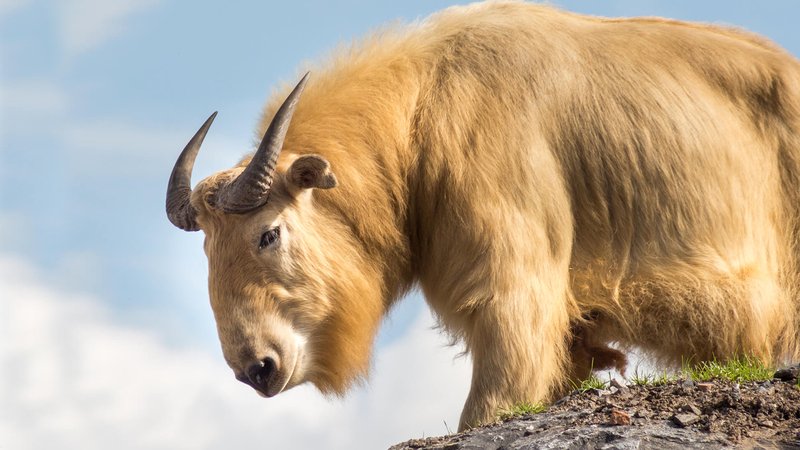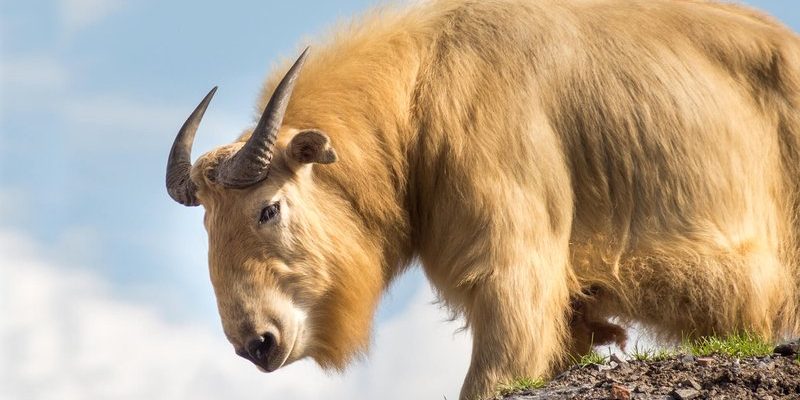
The takin is native to the rugged terrains of the Eastern Himalayas and parts of China and Bhutan. They’re not your average herbivores; they have a sturdy build and are perfectly adapted for life in steep, mountainous areas. Let’s dive into some of the most interesting details about the takin, from its unique physical traits to its social habits.
1. Unique Appearance
One of the standout features of the takin is its striking appearance. Imagine a creature with the body of a stocky goat, the head of a bison, and a sturdy set of legs—voilà, you’ve got yourself a takin! They are often described as having an almost cartoonish look, with a broad, flat nose and large eyes that give them a friendly yet robust demeanor.
The takin’s coat is equally impressive, covered in thick, shaggy fur that can range from golden brown to grayish-black. This thick fur isn’t just for show; it helps them stay warm in the cold temperatures of their mountainous habitats. It also acts as camouflage, blending seamlessly with the rocky terrain, which is essential for evading predators.
2. Habitat and Range
So where do takins call home? These fascinating animals prefer steep, rugged terrains found in mountain ranges across Asia. Their natural habitats include the Himalayas, Sichuan Province in China, and mountainous regions of Bhutan. They thrive in forests and alpine meadows, often at elevations of 3,000 to 4,000 meters (about 10,000 to 13,000 feet).
Their unique choice of habitat plays a crucial role in their lifestyle. The bumpy terrain provides safety from predators like leopards and wolves. Plus, the lush vegetation offers plenty of food. Takins are herbivores, feasting on grasses, leaves, and shrubs—all essential for their diet, especially in the harsh mountain climate.
3. Social Behavior
Takin may look a bit rugged, but they have a surprisingly social side. These animals typically gather in herds, which can range from a handful to a couple of dozen individuals. Herd dynamics play a significant role in their survival; being in a group provides safety from predators.
The social structure within a takin herd is quite fascinating. Males often engage in playful sparring to establish dominance, showcasing their strength and agility. During mating season, the competition among males heats up, leading to impressive displays of strength—like a natural, animal version of a competitive sports event.
4. Communication Skills
You might be surprised to learn that takin has its own way of communicating! They use a mix of vocalizations, body language, and even scent marking to interact with each other. For example, when threatened, they may emit a low grunt or whistle sound, alerting other members of the herd to danger.
Their body language is equally telling. If a takin is feeling threatened, you might notice it puffing its fur or standing tall, signaling to others to be alert. These communication methods help maintain group cohesion and ensure everyone stays safe in their mountainous home.
5. Interesting Diet
What do takins eat, you might ask? These sturdy animals are herbivores, primarily grazing on a diet of leaves, grasses, and shrubs. Their strong, muscular bodies are built for efficiently browsing through the dense vegetation found in their habitats.
In fact, their diet can be quite varied. Depending on the season, they might focus on leafy greens in the warmer months and switch to bark or twigs during the winter. This adaptability is crucial for survival, as food availability fluctuates with the weather conditions in their mountainous homes.
6. Conservation Status
Here’s the thing: despite their fascinating traits, takins face significant threats to their survival. They are classified as near threatened on the IUCN Red List. Habitat loss due to deforestation, hunting, and climate change are serious issues impacting their populations.
Conservation efforts are ongoing, with organizations working hard to protect their natural habitats and ensure the takin continues to roam the mountains. These initiatives include habitat restoration and legal protection against hunting, essential for keeping this unique species alive for future generations.
7. Cultural Significance
Takin aren’t just interesting because of their biology; they hold cultural significance too. In some regions, particularly in Bhutan, the takin is considered a national symbol. It’s even believed that the takin was created from the bones of a cow and the skin of a goat by a revered Buddhist saint!
This cultural connection highlights how intertwined the species is with the people living in their habitats. Understanding the takin’s role in local folklore and traditions helps underscore the importance of conservation efforts, as protecting them also means preserving part of the cultural heritage.
8. Breeding and Lifecycle
When it comes to breeding, takins follow a unique cycle. The mating season typically occurs in late autumn, and after a gestation period of about seven months, a single calf is born in the spring. These calves are quite precious; they stay with their mothers for up to a year, learning essential survival skills.
Interestingly, the mother takin is very protective. She’ll often lead her calf to safe spots while teaching it how to forage for food. This nurturing behavior is crucial for the calf’s development and survival in the wild.
9. Adaptations to Harsh Environments
Living in mountainous regions requires some remarkable adaptations. Takin have evolved several traits that help them thrive in these harsh environments. Their sturdy legs enable them to navigate steep and rocky terrains effortlessly, while their thick fur keeps them warm during cold nights.
Moreover, their unique digestive system is adapted to breaking down tough, fibrous plant material, which is essential in the nutrient-poor vegetation found in their habitats. This set of adaptations allows takins to not just survive, but thrive among the peaks of the Himalayas.
10. Fun Facts to Remember
To wrap up our exploration of the takin, here are some fun facts to remember:
- Nickname: Takin are sometimes called “goat-antelopes” due to their unique traits.
- Weight Class: Adult takins can weigh between 220 to 770 pounds, making them quite sizable.
- Life Expectancy: In the wild, takins can live up to 15 years, but in captivity, they can live even longer!
- Behavioral Adaptations: Takins are known for their remarkable ability to swim, which helps them cross rivers in their habitats.
In summary, the takin is truly a remarkable animal that deserves our attention. From their unique appearance and social behavior to their role in local cultures and conservation efforts, takins have a lot more to offer than meets the eye. Understanding these fascinating facts about the takin not only enriches our knowledge of the natural world but also highlights the importance of protecting such unique species in our ever-changing environment. Let’s celebrate these incredible creatures and work together to ensure their continued existence!

